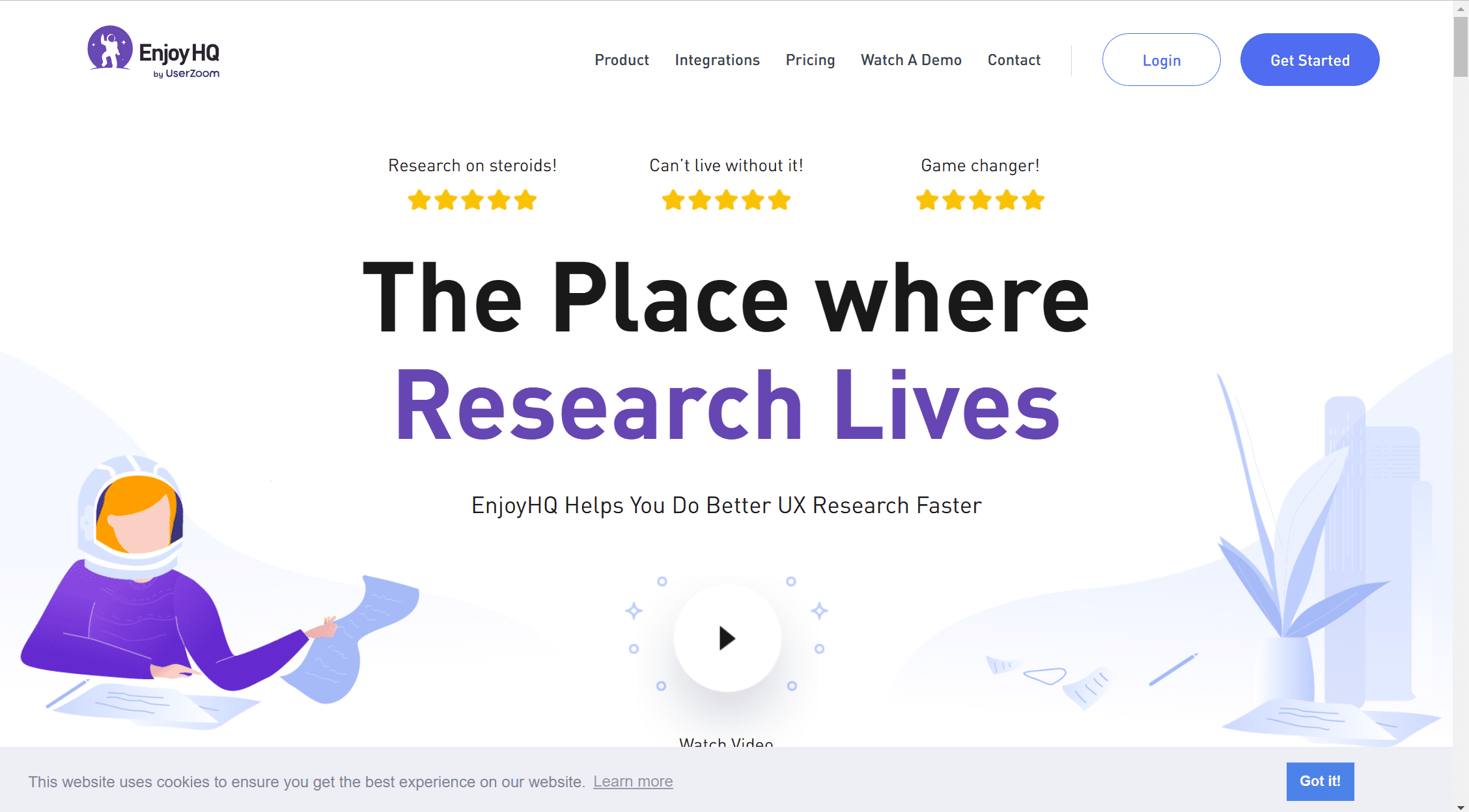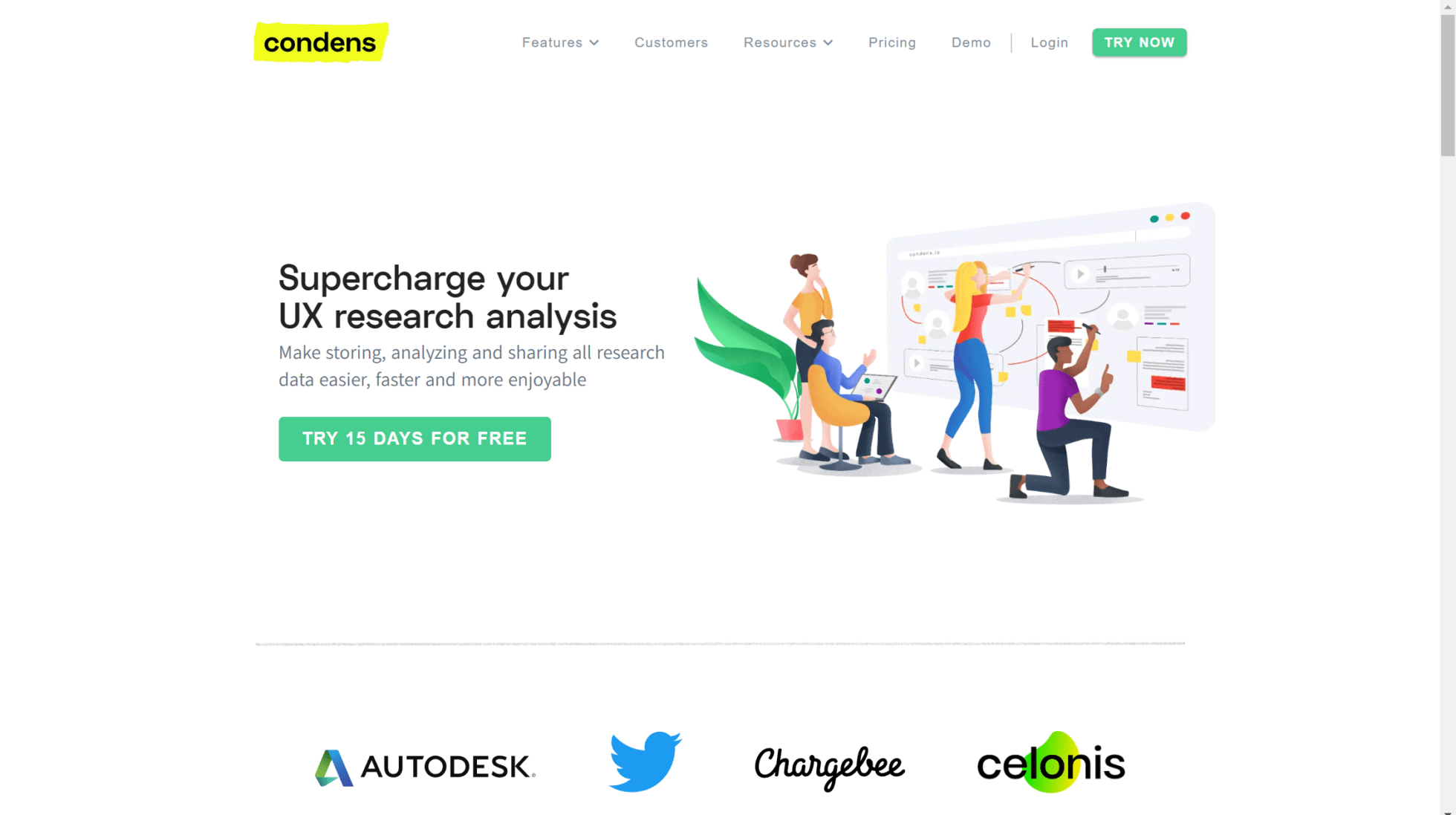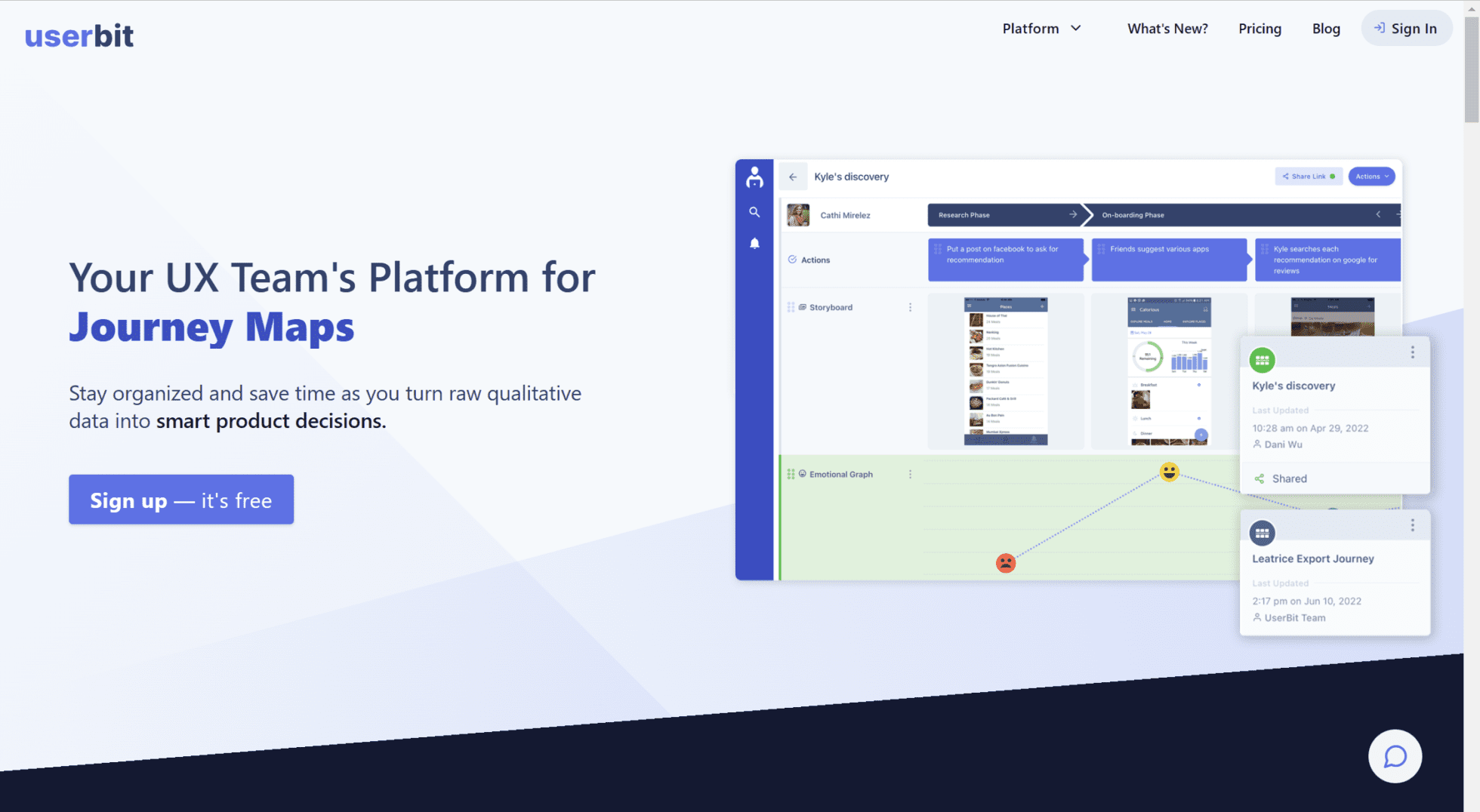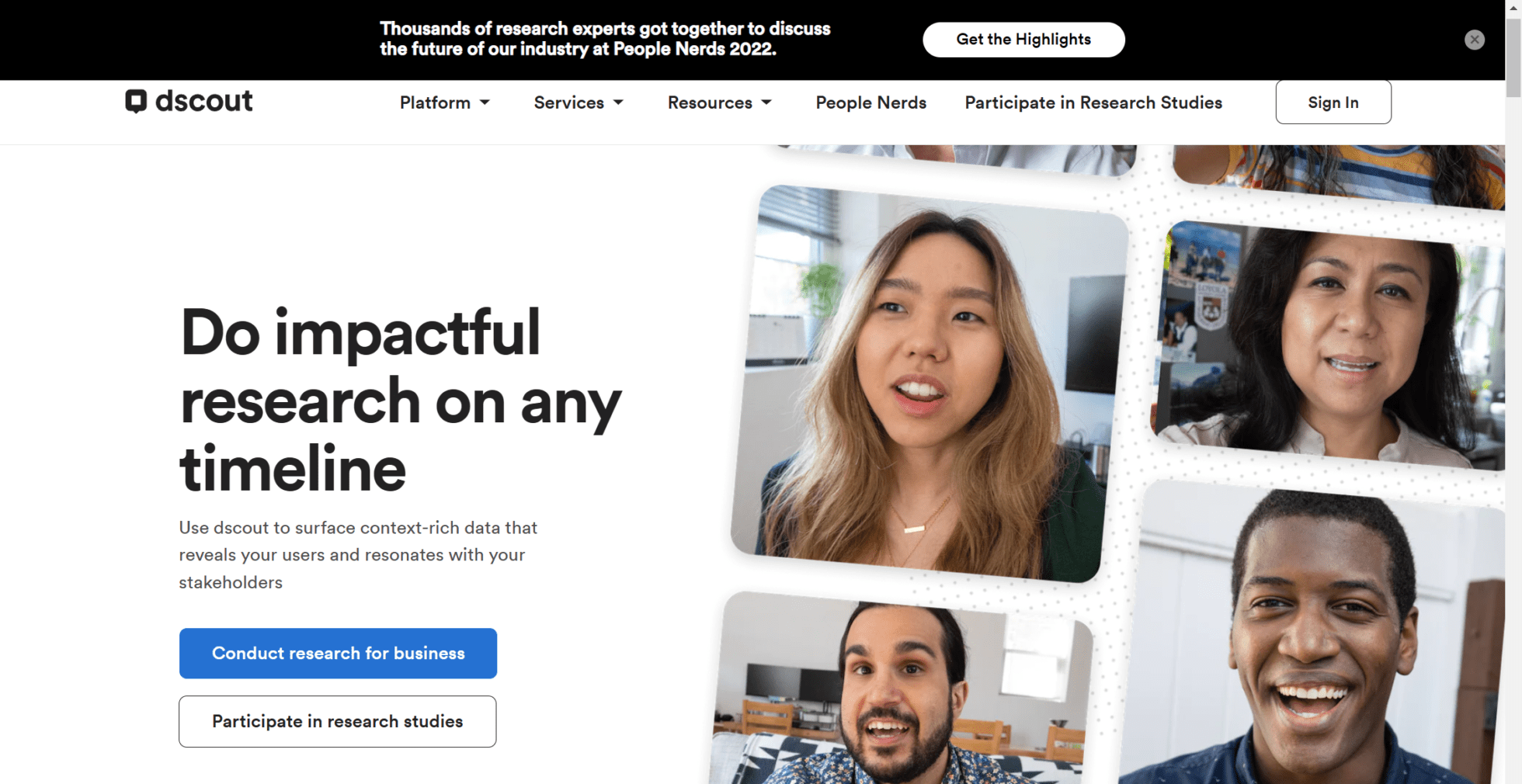Machen wir uns nichts vor: Dovetail ist ein fantastisches Kundenarchivierungs-Tool für diejenigen, die wissen, wie es funktioniert - und für diejenigen, die Geld zum Verbrennen haben. Leider bleibt die große Mehrheit von uns auf der Suche nach einem Dovetail Konkurrenten, der billiger und leichter zu verstehen ist.
Wir brauchen eine Wissensdatenbank für unsere Kunden, in der wir alle Daten aus der Nutzerforschung an einem Ort speichern können. Ein Ort, der einfach zu navigieren ist, so dass wir die Forschungsergebnisse leicht weitergeben können, und der skalierbar ist, so dass wir ständig neue Erkenntnisse gewinnen können. Wir möchten außerdem, dass die Datenbank kostenlos und leicht verständlich ist...
Klingt "mehr für weniger" zu schön, um wahr zu sein? Ist es zu viel verlangt, ein anständiges Endlager zu haben, das nicht die Welt kostet, und vielleicht einen Applaus nach getaner Arbeit?
@tldv.io Zu freundlich! Zu nett! #Produkt #Produktmanagement #Startup #Applaus #Komödie
♬ Originalton - tldv.io - KI-Meeting-Recorder
Das ist es nicht. Diese Liste der kostenlosen Dovetail Alternativen bietet Ihnen mehr als genug Möglichkeiten, um mehr für weniger Geld zu bekommen.
Aber zuerst: Ist Dovetail das wert?
Ist Dovetail es wert?
Es besteht kein Zweifel: Für das richtige Team ist Dovetail ein mächtiges Werkzeug. Manche würden sogar behaupten, es sei eines der besten in der Branche.
In den falschen Händen kann Dovetail jedoch zu einer massiven Geldverschwendung werden. Ganz zu schweigen von der Zeit, die man aufwenden muss, um zu lernen, wie die Software funktioniert. Das ist leider nicht einfach.
Pro und Kontra
Sie hat eine Menge positiver Aspekte:
- Speichern Sie all Ihre Recherchematerialien an einem Ort und visualisieren Sie sie einfach mit Reisekarten und mehr
- Entdecken Sie Forschungsmuster in Dovetail, dem leistungsstarken Repository für Erkenntnisse.
- Einfacher Export von Daten
- Unbegrenzter Speicherplatz für Aufnahmen, Dateien, Notizen, Fotos und Berichte jeder Art
- Professionelle Forschungsberichte im Handumdrehen erstellen
- Zusammenarbeit mit mehreren Benutzern und Nutzung flexibler Anmerkungswerkzeuge
Leider gibt es auf Dovetail nicht nur Sonnenschein und Regenbögen.
Hier sind einige der Nachteile vonDovetail:
- Kompliziert zu erlernen, daher nicht geeignet, um Interessengruppen außerhalb der Nutzerforschung zu überzeugen
- Die Benutzeroberfläche ist nicht so intuitiv wie sie sein könnte
- Wenn die Funktion "Einblicke" nicht ausreicht, werden Sie ein anderes Tool ebenso häufig verwenden
- Sitzungen müssen von einem externen Aufnahmegerät heruntergeladen und dann manuell in Dovetail hochgeladen werden, was wertvolle Zeit kostettl;dv sind die Aufzeichnungen und Abschriften sofort nach Ende der Sitzung verfügbar und können mit einem einfachen Kopieren/Einfügen hochgeladen werden)
- Sie müssen warten, bis die Transkription erstellt ist, und es gibt keine Sprechertags oder Hervorhebungentl;dvdie Sprechertags vontl;dvwerden automatisch hinzugefügt, und Hervorhebungen sind ganz einfach zu erstellen)
- Begrenzte Dateitypen: Audio-, Video- und Bilddateien können hochgeladen werden, aber dies deckt möglicherweise nicht alle Arten von Recherchen ab.
- Der hohe Preis kann die meisten Unternehmen abschrecken
Wie Sie sehen können, sind das ziemlich viele Nachteile für eine so teure Software.
Dovetail Preisgestaltung
Sie können das Basispaket Dovetail kostenlos nutzen, aber es ist wahrscheinlich nicht von großem Nutzen.
Funktionen des kostenlosen Plans
- Unbegrenzte Projekte
- 3 Transkriptionsstunden pro Monat
- Nur für Einzelpersonen
Natürlich ist dieser Plan großartig, um die Software kennenzulernen, bevor man sich für einen kostenpflichtigen Plan entscheidet, aber es gibt weitaus bessere kostenlose Pläne. Und die kostenpflichtigen Pläne können ziemlich wucherisch sein...
Wenn Sie sich für den Business-Plan für 15 Benutzer entscheiden, kostet Sie das satte 900 Dollar pro Monat. Der Preis für Enterprise liegt weit darüber, je nachdem, wie viele Mitarbeiter Sie haben, die die Software nutzen werden.
In diesen wirtschaftlich schwierigen Zeiten wollen Unternehmen den Wert der Erkenntnisse aus der Nutzerforschung maximieren und gleichzeitig die Kosten so gering wie möglich halten. Aus diesem Grund haben wir diese Liste mit Dovetail Alternativen erstellt. Wir werden zwei Arten von Dovetail Wettbewerbern behandeln:
- Dovetail Alternativen, die erschwinglicher sind - oder kostenlos!
- Dovetail Alternativen, die für Nicht-UX-Mitarbeiter besser geeignet sind und daher im gesamten Unternehmen leichter verwendet werden können
Diese beiden Arten von Wettbewerbern decken die wichtigsten Einschränkungen von Dovetail ab und versuchen, diese mit anderen UX-Forschungsrepositorien zu beheben.
Spezialisieren oder nicht spezialisieren
Unabhängig davon, ob Sie sich für ein spezialisiertes UX-Repository (z. B. Dovetail) entscheiden oder eine Mehrzweckplattform als Wissensdatenbank für Ihre Kunden nutzen (z. B. Notion oder Confluence) - Intuitivität, Onboarding und einfache Akzeptanz sind entscheidend, wenn Sie möchten, dass die Erkenntnisse der Benutzer eine größere Wirkung in Ihrem Unternehmen entfalten.
Dies ist der Punkt, an dem es Dovetail mangelt. Da sie so spezialisiert ist, werden Nicht-US-Akteure wahrscheinlich von all den saftigen Forschungsergebnissen ausgeschlossen. Und wozu ist sie dann gut?
Ein entscheidender Schritt auf dem Weg zur Nutzerforschung ist es, denjenigen, die die Entscheidungen treffen sollen, den Zugang zu Ihrer Forschung zu erleichtern. Wenn Sie sich für eine Software entscheiden, auf die die Beteiligten nicht zugreifen können (wie z. B. Dovetail), machen Sie sich die Arbeit schwerer als sie sein müsste.
Bonus-Tool zur Verbesserung ALLER Forschungsrepositorien
Bevor wir mit der Liste der Dovetail Alternativen beginnen, müssen wir Ihnen einen Weg zeigen, wie Sie Zeit, Energie und Geld sparen können, unabhängig davon, für welches Kundenrepository Sie sich entscheiden.
Das nennt man tl;dv.
tl;dv - Das unverzichtbare UX Research Tool
tl;dv ist ein remote , das speziell entwickelt wurde, um Ihnen Zeit zu sparen, indem es die Aufnahme, Speicherung, Analyse und Weitergabe von Nutzerinterviews im Videoformat vereinfacht.
Vorbei sind die Zeiten, in denen man sich viele Notizen machen und versuchen musste, Erkenntnisse mit Stift und Papier festzuhalten. tl;dv Notetaker für Google Meet und Zoom ermöglicht es Ihnen, Notizen zu verfassen und bestimmte Zeitpunkte im Video wie Lesezeichen zu markieren. Noch beeindruckender ist, dass diese Zeitstempel mit einem einfachen Klick direkt an Stakeholder oder Designer weitergegeben werden können, um ihnen unvoreingenommene Einblicke direkt von der Stimme des Kunden zu geben.
Sie bevorzugen automatische Notizen? tl;dvbietet Ihnen auch das. Die leistungsstarke KI von tl;dv kann im Verlauf des Meetings automatische Notizen erstellen, das Meeting am Ende zusammenfassen oder sogar aus dem Videomaterial Ihres Gesprächs gemeinsam nutzbare Highlight-Reels erstellen!
Mit tl;dv können Sie die Emotionen und Bedürfnisse Ihrer Nutzer so genau wie möglich erfassen - in ihren eigenen Worten. Noch nie war es so einfach, Nutzerfeedback zu analysieren und entsprechend zu planen. Verbinden Sie tl;dv einfach mit dem UX Research Repository Ihrer Wahl und speichern Sie schnell und einfach alle Ihre Lieblingsclips aus Nutzerinterviews, so dass Sie jederzeit zurückspringen und sie erneut ansehen können.
tl;dv ist nicht nursuper intuitiv, leicht zu übernehmen und lässt sich nahtlos in alle Ihre bestehenden Arbeitsplattformen wie Slack, Notion und Google Docs integrieren, sondern ist auch kostenlos erhältlich! Schauen Sie sich hier den Freemium-Plan an, der unbegrenzte Aufnahmen, Transkriptionen, Highlights und Zeitstempel beinhaltet.
Wo ist der Haken?

Der Haken ist das mulmige Gefühl, das Sie haben werden, wenn Sie feststellen, dass Sie nicht die ganze Zeit tl;dv benutzt haben.
Wenn man an all die Stunden denkt, die man mit dem manuellen Exportieren von Videoaufnahmen, dem geduldigen Warten auf die Erstellung von Transkriptionen, dem unermüdlichen Hinzufügen von Sprechertags und der Kennzeichnung aller wichtigen Erkenntnisse vergeudet hat, nur um dann festzustellen, dass tl;dv all dies automatisch und in Sekundenschnelle erledigt... Nun, sagen wir einfach, es ist zu viel für manche Leute.
Gehören Sie nicht zu diesen Leuten.
Die 5 besten Dovetail Alternativen
1. EnjoyHQ

EnjoyHQ hat sich zum Ziel gesetzt, das Problem des Kundenfeedbacks zu lösen. Es kann schwierig sein, sich einen Reim darauf zu machen, besonders wenn es fragmentiert und über mehrere Systeme und Teams verteilt ist. EnjoyHQ ist eine Wissensdatenbank für Kunden, in der Sie die gesamte Nutzerforschung sammeln und endlich klar verstehen können, was Ihre Kunden sagen. Mit EnjoyHQ können Sie Kundenfeedback einfach suchen, organisieren und mit Ihrem Team teilen.
"Ich beschreibe EnjoyHQ als einen Ort der Wahrheit, den Ort, an dem die Forschung lebt."
Genevieve Kelly - Produktdesignerin und leitende UX-Forscherin bei Proposify Tweet
Profis
- Erstklassiger Kundenservice
- Leistungsstarke Suchmaschine mit flexiblen Filtern
- Alle Forschungsdaten an einem Ort verfügbar
Nachteile
- Kann recht kompliziert zu erlernen sein, was einige Funktionen unbrauchbar macht und es unwahrscheinlich macht, dass die Beteiligten einfachen Zugang zu Ihren Ergebnissen haben.
- Der günstigste kostenpflichtige Tarif beträgt 1.000 Dollar pro Monat.
- Aufzeichnungen müssen manuell hochgeladen werden, die Erstellung von Transkriptionen nimmt Zeit in Anspruch, und Sie müssen die Erkenntnisse aus Benutzerinterviews manuell kennzeichnen.
Profi-Tipp: Laden Sie tl;dv für Zoom oder Google Meet um Videos schnell und automatisch aufzunehmen, zu transkribieren, herunterzuladen, hochzuladen und mit einem Zeitstempel zu versehen.
Preise
Wie bereits im Abschnitt "Nachteile" erwähnt, beträgt der günstigste kostenpflichtige Tarif von EnjoyHQ 1.000 US-Dollar pro Monat, was ziemlich verrückt ist.
Allerdings bieten sie einen kostenlosen Plan, der das mickrige Angebot von Dovetailin den Schatten stellt.
Funktionen des kostenlosen Plans
- 2 Verwaltungssitze
- Unbegrenzte Nur-Lese-Benutzer
- Unbegrenzte Forschungsprojekte
- Unbegrenzte Uploads: Text, Bilder, Anhänge.
- Datenvisualisierungen
- Unbegrenzte Transkriptionen
- Videobearbeitungsfunktionen
- Taxonomie-Manager
- Integrationen: UserZoom, Slack, Zapier, Trello, Jira, E-Mail, Google Drive, OneDrive, Dropbox, Box, und Zoom
Für mehr Verwaltungsplätze und einige zusätzliche Funktionen können Sie sich für den Grow-Plan oder den anpassbaren Scale-Plan entscheiden. Probieren Sie sie hier aus.
EnjoyHQ vs. Dovetail
Es mag so klingen, als ob EnjoyHQ und Dovetail unter sehr ähnlichen Beschwerden leiden: teure kostenpflichtige Pläne, schwer zu erlernen und zeitaufwändig, wenn es um Videoaufzeichnungen geht, ohne die Einbeziehung der tl;dv Meeting-Recorder-Technologie. Der kostenlose Tarif von EnjoyHQ bietet jedoch genügend interessante Funktionen, um sich in die Materie einzuarbeiten, während dies bei Dovetaileinfach nicht der Fall ist.
Wenn Sie in einem kleinen Team (2 Personen) arbeiten, kann das sogar ausreichen.
2. Kondenswasser

Condens ist für Sie und Ihr Team gedacht, um Nutzerforschungsdaten zu speichern, zu strukturieren und zu analysieren und die Ergebnisse in Ihrem Unternehmen zu teilen. Es behauptet, Ihre UX-Forschungsanalyse zu optimieren. Aber macht es das besser als Dovetail?
"Ein großartiges Werkzeug zur Forschungsanalyse. Einfach zu bedienen und ziemlich vollständig."
Raffaella - Leiterin der Abteilung Entdeckung bei FifthBeat Tweet
Profis
- Automatische Transkription
- Videoclips und Highlight-Reels
- Organisieren von Beweisen mit Affinitätsclustern
- Teilen Sie Ihre Arbeit mit Kunden und Stakeholdern an einem Ort für eine einfache Zusammenarbeit
- Durchführung von Nutzerforschung aus der Ferne und Erreichen eines größeren und vielfältigeren Teilnehmerkreises
- Erweiterte Analyse- und Berichterstattungsfunktionen zur Gewinnung besserer Erkenntnisse
Nachteile
- Keine nativen Integrationen
- Kompliziert zu erlernen, daher nicht geeignet, um Interessengruppen außerhalb der Nutzerforschung zu überzeugen
- Sitzungen müssen von einem externen Aufnahmegerät heruntergeladen und dann manuell in Condens hochgeladen werden, was wertvolle Zeit kostettl;dvdie Aufnahmen und Transkriptionen vontl;dvsind sofort verfügbar und können durch Kopieren und Einfügen hochgeladen werden)
- Sie müssen warten, bis die Transkription erstellt ist, und es gibt keine Sprechertags oder Hervorhebungentl;dvdie Transkriptionen vontl;dv werden sofort erstellt, die Sprechertags werden automatisch hinzugefügt, und die Hervorhebungen lassen sich ganz einfach erstellen)
- Die Anpassungsmöglichkeiten sind begrenzt
- Das Tool ist nicht unbedingt für alle Arten von Forschungsprojekten geeignet
- Kein kostenloser Plan
Preise
Condens bietet keinen kostenlosen Plan an. Es gibt jedoch eine kostenlose Testversion mit einer Laufzeit von 15 Tagen. Das ist genug Zeit, um das Tool (mit all seinen zahlreichen Funktionen) auszuprobieren und herauszufinden, ob es das Richtige für Sie ist, bevor Sie sich für einen kostenpflichtigen Plan entscheiden.
Der günstigste Plan ist der Einzelplan, der derzeit bei 33 Dollar pro Monat für eine Person liegt.
Individuelle Planmerkmale
- Eine Forscherin
- 180 Stunden automatisierte Transkription pro Jahr
- Basis-Integrationen
- Unbegrenzte Projekte und Datei-Uploads
- Unbegrenzte Freigabe von Befunden im Nur-Lese-Modus
- Persönliche Betreuung und Einarbeitung
Ab hier steigen die Tarife von 33 $ auf 135 $, wobei die Anzahl der Forscher auf bis zu 5 erhöht und einige zusätzliche Funktionen freigeschaltet werden. Weitere Informationen finden Sie in der Preisübersicht von Condens.
Es gibt auch einen projektbasierten Plan, der ideal für Freiberufler ist. Eine einmalige Zahlung von 50 $ schaltet mehrere wichtige Funktionen für bis zu 6 Monate frei.
Kondenswasser vs. Dovetail
Condens und Dovetail sind sich in vielerlei Hinsicht ähnlich. Beide sind spezialisierte Kundenrepositorien, und beiden fehlt die Zugänglichkeit, um Stakeholder mit ihrer Komplexität zu überzeugen.
Während Dovetail ein kostenloses Angebot mit sehr eingeschränkten Funktionen hat, bietet Condens eine kostenlose Testversion mit allen Funktionen. Die 15-Tage-Frist mag sich zwar einschränkend anfühlen, aber Sie können die Funktionen von Condens wirklich kennenlernen, indem Sie sie nutzen, bevor Sie bezahlen.
3. UserBit

UserBit ist eine auf Journey Maps spezialisierte Plattform für Kundenwissen, die es Ihnen ermöglicht, "organisiert zu bleiben und Zeit zu sparen, während Sie qualitative Rohdaten in intelligente Produktentscheidungen umwandeln".
Es konzentriert sich auf die Zusammenarbeit und ermöglicht es Ihnen, aus der Ferne und gleichzeitig mit Ihren Kollegen zu arbeiten.
"Das Team ist unglaublich reaktionsschnell. Das einzige Mal, dass ich so schnell eine Lösung bekommen habe, war, als der Entwickler buchstäblich mein Mann war!"
Crystal Dionysopoulou - Kreativdirektorin und Gründerin, Lucid Fox Tweet
Profis
- Zusammenarbeit mit Ihrem Team in Echtzeit von jedem Ort der Welt aus
- Ermöglicht eine schnelle und effiziente Analyse von textlastigen qualitativen Daten
- Großartige Kundenbetreuung
- Großartig für UX-Designer, um alles zu speichern, was mit UX zu tun hat
Nachteile
- Kompliziert zu erlernen und schwer zugänglich für Akteure, die es nicht regelmäßig nutzen
- Sitzungen müssen von einem externen Rekorder heruntergeladen und dann manuell hochgeladen werden (es sei denn, Sie koppeln es mit tl;dv und erhalten sofortige Downloads und laden es mit Kopieren/Einfügen hoch)
- Sie müssen warten, bis die Transkription erstellt ist, und es gibt keine Sprechertags oder Hervorhebungentl;dvdie Transkriptionen und Sprechertags vontl;dvsind automatisch, während Hervorhebungen unglaublich einfach zu erstellen sind)
Preise
UserBit bietet einen fantastischen kostenlosen Plan an, mit dem Sie sich mit den Funktionen vertraut machen und herausfinden können, ob Sie die kostenpflichtige Version kaufen möchten oder nicht. Der erste kostenpflichtige Plan beginnt bei 60 $ pro Monat, aber wenn Ihr Team klein ist, können Sie durchaus in der Lage sein, mit der kostenlosen Version auskommen.
Funktionen des kostenlosen Plans
- 1 Repository-Projekt
- Teilnehmer-CRM
- Interview-Management
- Anmerkungen und Medien
- Analyse der Umfragedaten
- Kennzeichnung und Analyse
- Einblicke und Berichte
- 2 Persönlichkeiten
- 2 Anfahrtskarten
- 2 Flussdiagramme
- 2 Studien zur Kartensortierung
- 2 Visuelle Sitemaps
- Unbegrenzte Anzahl von Teammitgliedern
- 5 GB Speicherplatz
- 2-Faktor-Authentifizierung
Wie Sie sehen können, enthält der kostenlose Plan eine Vielzahl von Funktionen. Leider eignen sie sich nicht für größere Forschungsprojekte oder Kundenrepositorien für größere Teams.
UserBit gegen Dovetail
UserBit hat ein stärkeres kostenloses Angebot als Dovetail und ist vielleicht ein wenig benutzerfreundlicher, aber immer noch für UX-Forscher konzipiert. In diesem Fall erleidet es das gleiche Schicksal wie Dovetail , da es nicht in der Lage ist, die wichtigen Entscheidungsträger des Unternehmens zu erreichen.
Wenn Ihre Forschung keinen Einfluss auf diejenigen hat, die die Entscheidungen treffen, ist sie im Grunde nutzlos. Durch die Verknüpfung von UserBit mit tl;dvkönnen Sie Highlights aus Nutzerinterviews direkt in das Repository Ihrer Wahl kopieren und einfügen.
4. Dscout

Dscout ist ein Mitbewerber von Dovetail , der sich auf kontextreiche Daten konzentriert, die bei Ihren Stakeholdern Resonanz finden. Endlich haben wir ein Kundenwissenstool, das die Bedeutung der Beeinflussung von Interessengruppen anerkennt. Aber ist Dscout das richtige Werkzeug für diese Aufgabe?
Finden wir es heraus.
"Dscout hilft Nicht-Forschern, sich in unsere Nutzer einzufühlen. Die Plattform ermöglicht es uns, die Stimme der Kunden zu erfassen und ihre Perspektiven bei Lenovo zu teilen."
Dilip Bhatia - Chief Customer Experience Officer bei Lenovo Tweet
Profis
- Großartige Möglichkeit zur Visualisierung von Forschungsdaten
- Hilft bei der Rekrutierung von Nutzern für Studien ohne den Aufwand und die Kosten herkömmlicher Methoden
- Hilft Nicht-Forschern, sich in die Nutzer einzufühlen
Nachteile
- Begrenzt auf mobile und Webanwendungen
- Das Hochladen von externen Videoaufnahmen muss manuell erfolgen, ebenso wie die Beschriftung von Einblicken (im Gegensatz zur Kopieren/Einfügen-Funktion von tl;dv die KI-generierte Tags hat)
- Die Erstellung von Transkriptionen nimmt Zeit in Anspruch (im Gegensatz zu den Soforttranskriptionen von tl;dv)
Preise
Für die Preise von Dscout müssen Sie sich direkt an das Unternehmen wenden. Sie können die Funktionen unter " Abonnements" einsehen und alle Pläne sind anpassbar.
Dscout gegen Dovetail
Dscout löst definitiv einige der Probleme, die Dovetail hat, allerdings variiert der Preis von Projekt zu Projekt. In gewisser Weise ist das eine gute Sache, denn es bedeutet, dass Sie nur für das bezahlen, was Sie brauchen, und nichts darüber hinaus. Allerdings ist es eine zusätzliche Hürde, bei Dscout ein Angebot einzuholen, die Dovetail nicht hat.
Es hat einige vielversprechende Referenzen, aber ohne einen kostenlosen Plan, um zu testen, ob es für Ihre Bedürfnisse funktioniert, hat Dscout eine Chance verpasst.
5. ProduktBoard

Productboard ist eines der am einfachsten zu bedienenden Kunden-Repositories auf dem Markt, aber es ist kein direkter Konkurrent von Dovetail , da sein Hauptaugenmerk auf dem Sortieren und Sammeln von Erkenntnissen liegt, die Sie anderswo gesammelt haben.
Productboard ist eine Produktmanagement-Plattform, die Ihnen hilft, die richtigen Produkte schneller auf den Markt zu bringen, indem sie die Bedürfnisse Ihrer Kunden versteht. Dabei hilft es Ihnen, Prioritäten und Strukturen zu setzen und Ihr gesamtes Team auf eine intuitive Roadmap auszurichten.
"Die Plattform hat unsere Fähigkeit verbessert, Produkte auf den Markt zu bringen und gleichzeitig das richtige Feedback von unseren Kunden einzuholen. Mit Productboard können wir uns auf die Entwicklung der besten Produkte für unsere Kunden konzentrieren."
Param Kahlon - Produktverantwortlicher bei UiPath Tweet
Profis
- Einbeziehung von Erkenntnissen aus vielen verschiedenen Forschungskanälen, einschließlich Fragebogen-Tools, Nutzerinterviews und Usability-Tests
- Einfaches Sammeln und Organisieren von Kundenfeedback
- Funktionen zur Priorisierung und Organisation von Produktentwicklungsaufgaben
- Kollaborationswerkzeuge für asynchrone und remote Arbeitsteams
- Integration mit anderen Tools wie Trello und Jira
Nachteile
- Kann für Neulinge schwierig zu erlernen sein, auch für Interessengruppen, die sich möglicherweise nur schwer anpassen können und daher keinen Zugang zu Ihrer Forschung haben
- Schwer anpassbar
- Die Kundenbetreuung kann verbessert werden
- Kann für kleine Unternehmen kostspielig sein
Preise
Mit der kostenlosen Testversion von Productboard können Sie eine Roadmap erstellen, um einige der Funktionen zu testen.
Funktionen des kostenlosen Plans
- 1 flexibler und konfigurierbarer Fahrplan
- Mit jedem teilen
- Zusammenarbeit mit unbegrenzten Machern
- Google Apps SSO
- Zugang zur Gemeinschaft der Produkthersteller
- Feedback sammeln
Es ist ein guter Einstieg in das Angebot von Productboard, aber es reicht nicht aus, um über längere Zeit oder an größeren Projekten zu arbeiten.
Wenn Sie eine unbegrenzte Anzahl von Produkten, Funktionen und Roadmaps benötigen, können Sie die kostenpflichtigen Pläne ab 20 US-Dollar pro Monat ausprobieren.
Produktkartei vs. Dovetail
Wie bereits erwähnt, ist Productboard kein direkter Konkurrent von Dovetail . Es ist zwar definitiv eine der Alternativen zu Dovetail und kann zur Erstellung einer Kunden-Wissensdatenbank verwendet werden, aber die Stärke von Productboard liegt in seiner Fähigkeit, verschiedene Wege der Nutzerforschung zu organisieren und zu sortieren.
In Verbindung mit einem Produktrecherchetool wie tl;dv wird es zu einem sehr starken Anwärter auf den Thron von Dovetail.
Dovetail Alternativen für Nicht-User
Wenn man es auf das Wesentliche herunterbricht,können Sie mit Dovetail Ihre Nutzerforschungsdaten an einem einzigen Ort speichern, wo Sie sie dann gemeinsam nutzen und analysieren können, um Erkenntnisse in großem Umfang zu gewinnen .
Es gibt zwar viele Dovetail Konkurrenten, die speziell für die UX-Welt entwickelt wurden, aber es gibt auch ein paar andere Tools, die Sie als Wissensdatenbank für Kunden nutzen können. Vielleicht nutzen Sie sogar schon einige davon, um den Onboarding-Prozess zu vereinfachen.
Hier sind vier, von denen jeder schon einmal gehört hat:
Diese allgemeineren Werkzeuge haben zwei Vorteile und einen Nachteil.
Profis
- Leichter Zugang für alle Teammitglieder, einschließlich Interessengruppen, Designer, Entwickler und Produktteams
- Sie sind nicht teuer - vielleicht benutzen Sie sie sogar schon
Nachteile
- Möglicherweise nicht geeignet für große UX-Forschungsprojekte mit spezifischen und spezialisierten Anforderungen
Bei komplexeren Kundenbeständen reichen diese Tools natürlich nicht aus. Wenn Sie große Datenmengen haben, kann es schwierig sein, diese in einem dieser Tools zu überblicken, aber für kleinere oder einfachere Forschungsaufgaben kann jedes dieser 4 Tools in eine Kundenwissensdatenbank umgewandelt werden und Ihrem Unternehmen eine Menge Zeit, Geld und Mühe sparen.
Eine Schlussbemerkung
Ein letzter Punkt: Ein Kundenrepository ist nur dann von Nutzen, wenn Sie Ihre Erkenntnisse klar und einfach hochladen und abrufen können.
Unabhängig davon, für welche der Dovetail Sie sich entscheiden, oder ob Sie bei Dovetail bleiben, sollten Sie Ihre Benutzerinterviews immer mit tl;dv aufzeichnen.
Die Aufzeichnung ist sofort nach Beendigung des Meetings verfügbar, die Transkription erfolgt sofort, und die Tags für die Sprecher und die Beschriftung der Erkenntnisse werden automatisch von KI generiert. Die Aufzeichnung kann auf einfache und intuitive Weise in Highlights der wichtigsten Erkenntnisse unterteilt und dann mit einem einfachen Kopieren und Einfügen auf JEDER von Ihnen verwendeten Plattform geteilt werden.
Eine Partnerschaft zwischen tl;dv und dem Repository Ihrer Wahl ist ein absolutes No-Brainer-Projekt! Vor allem, wenn Sie bedenken, dass es völlig kostenlos ist...














